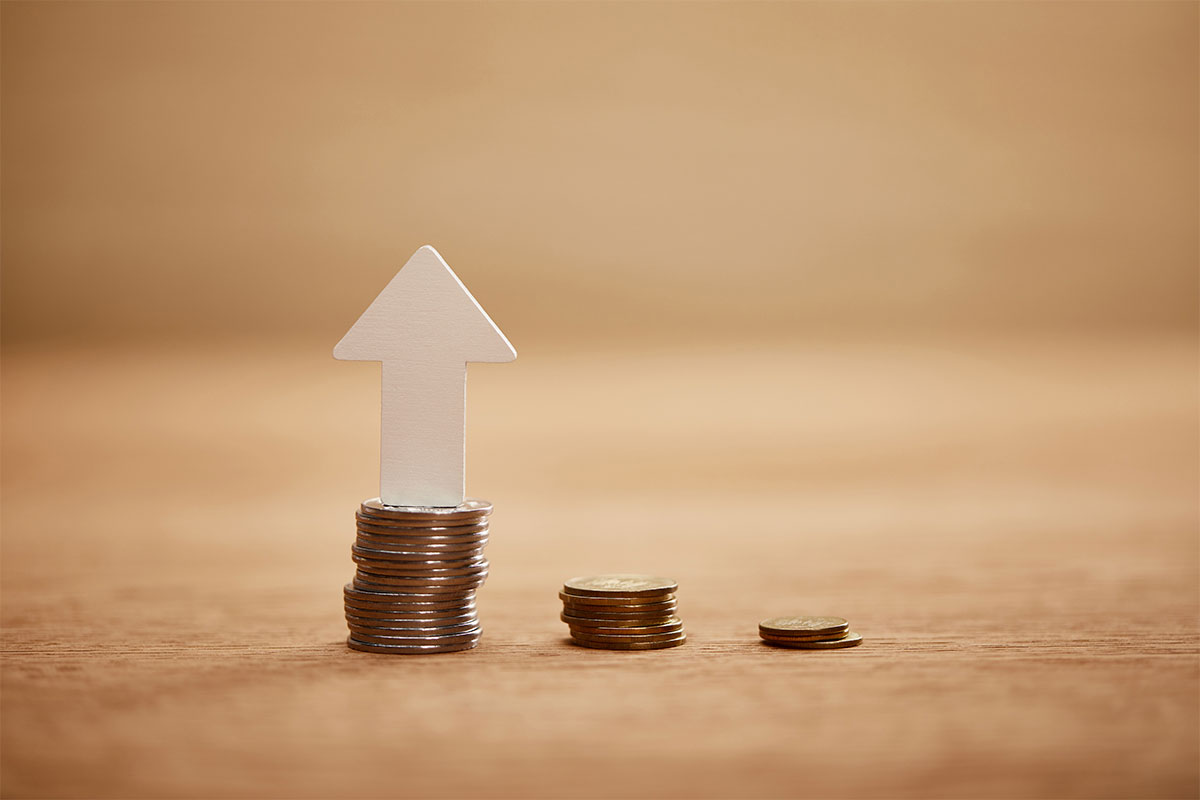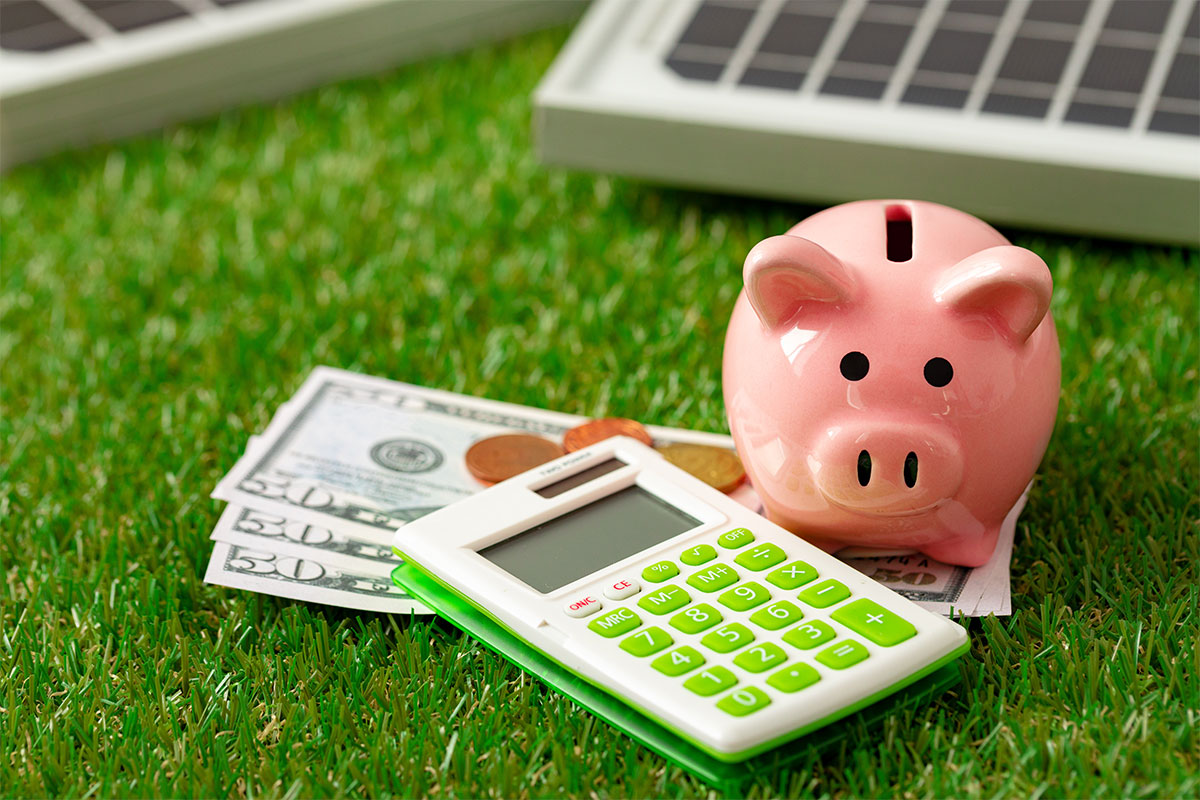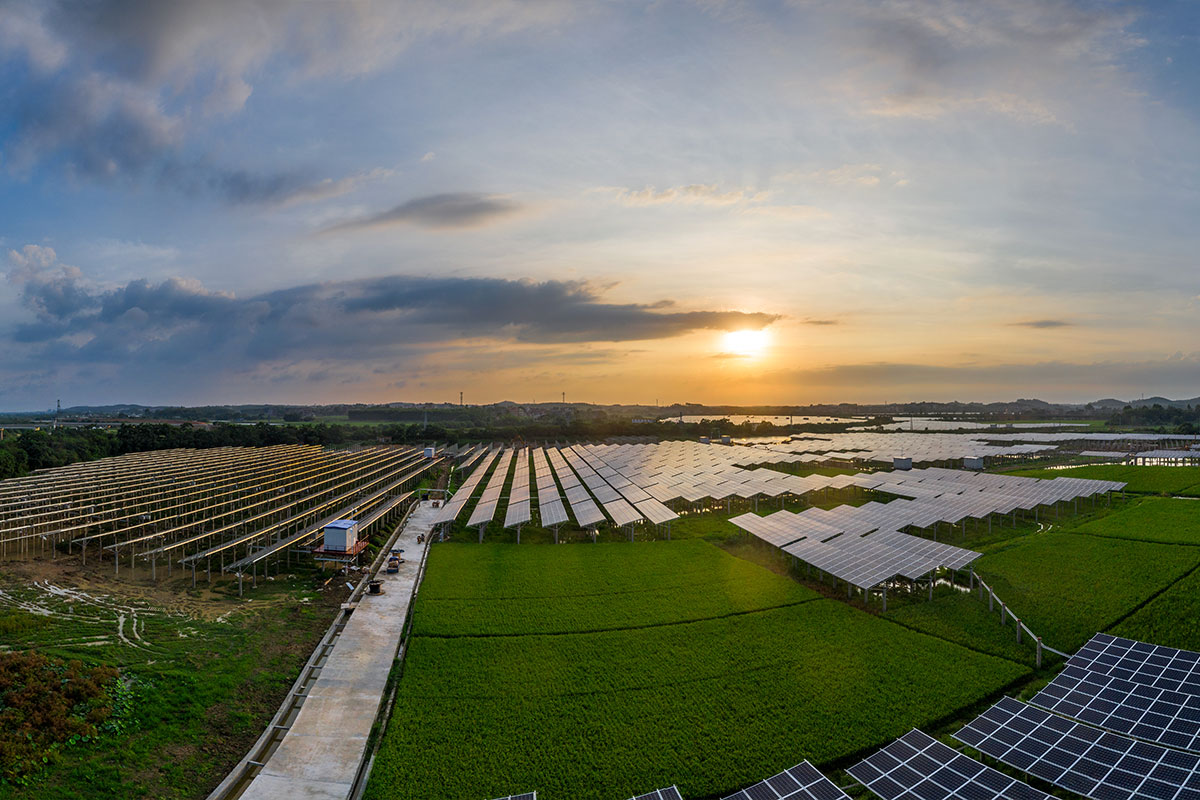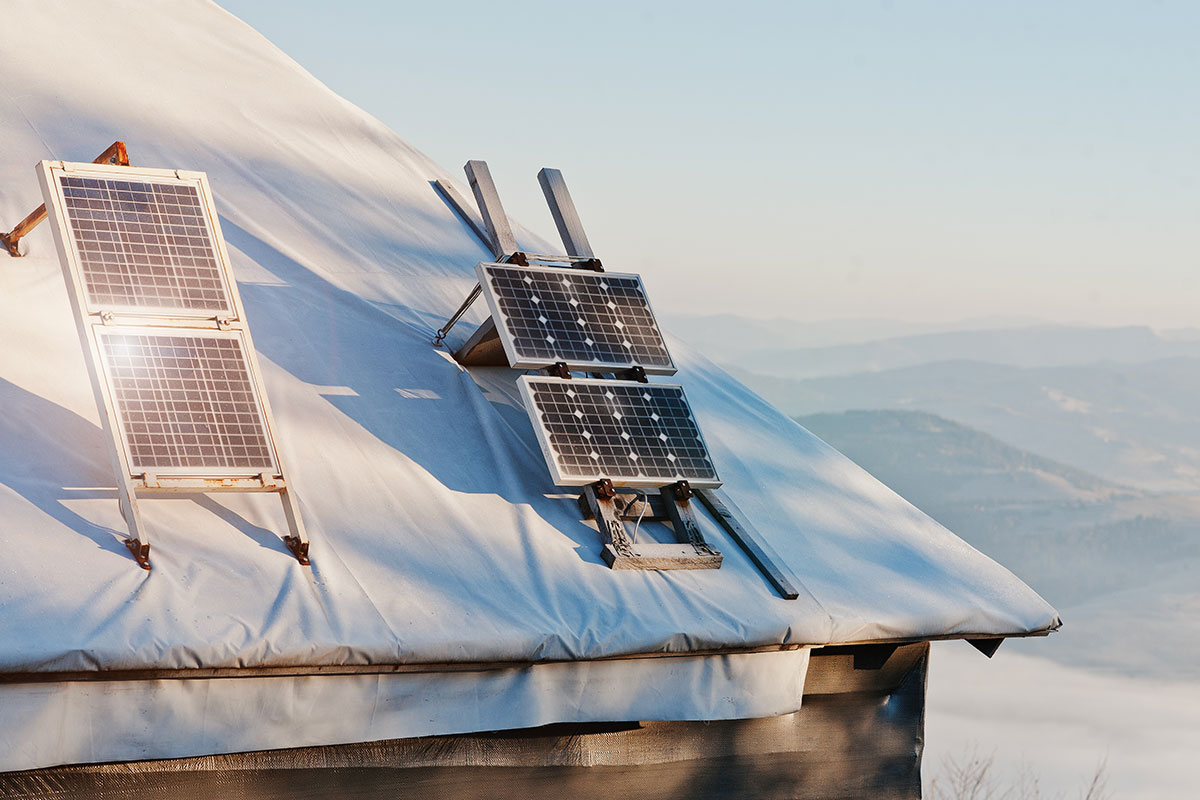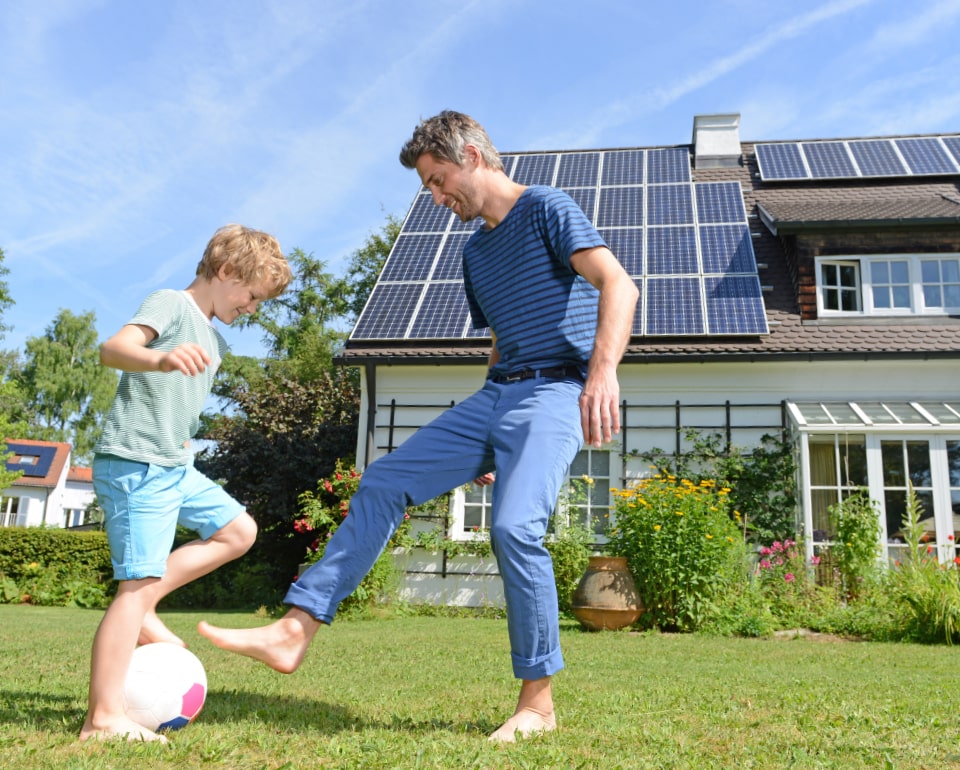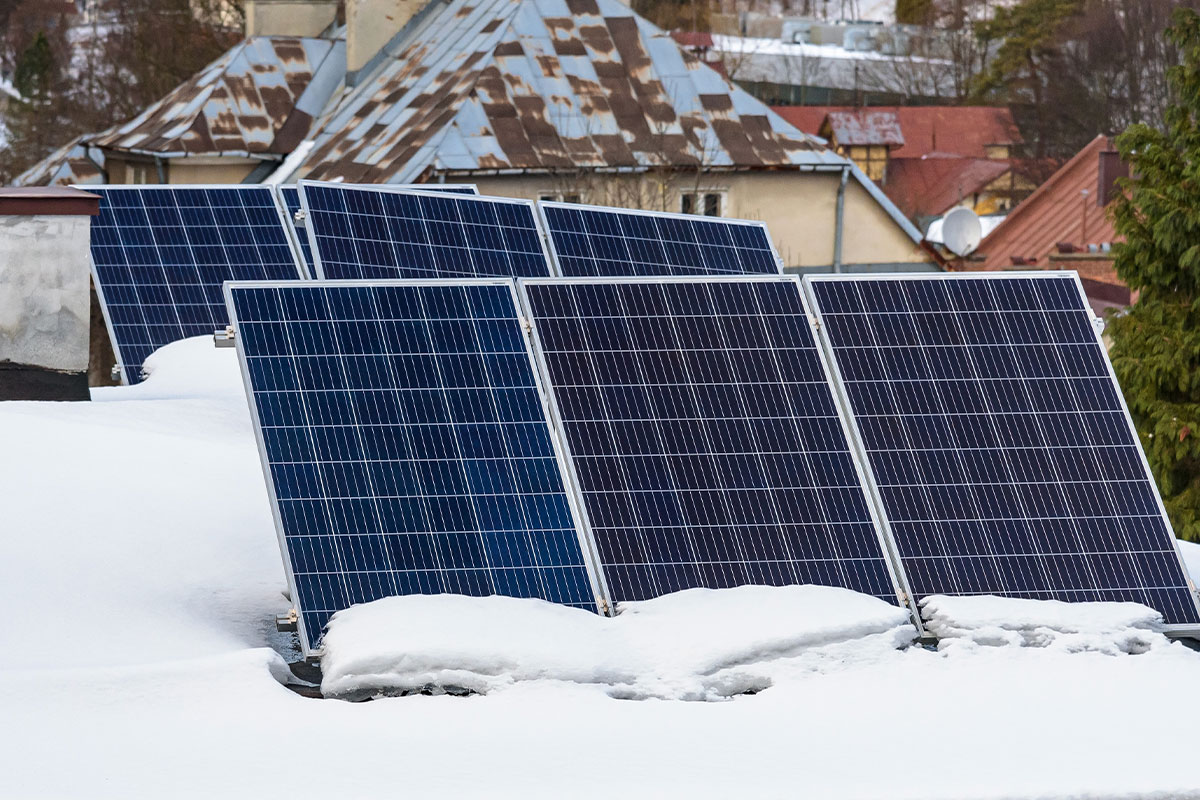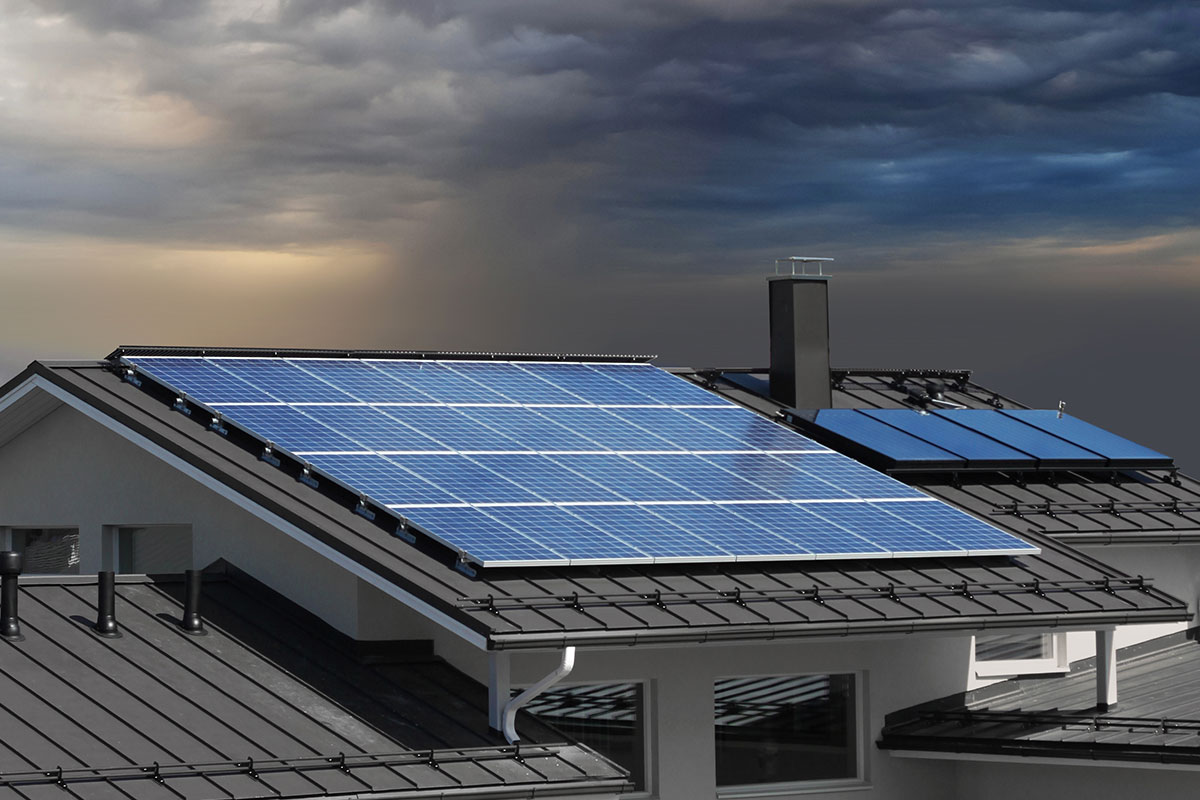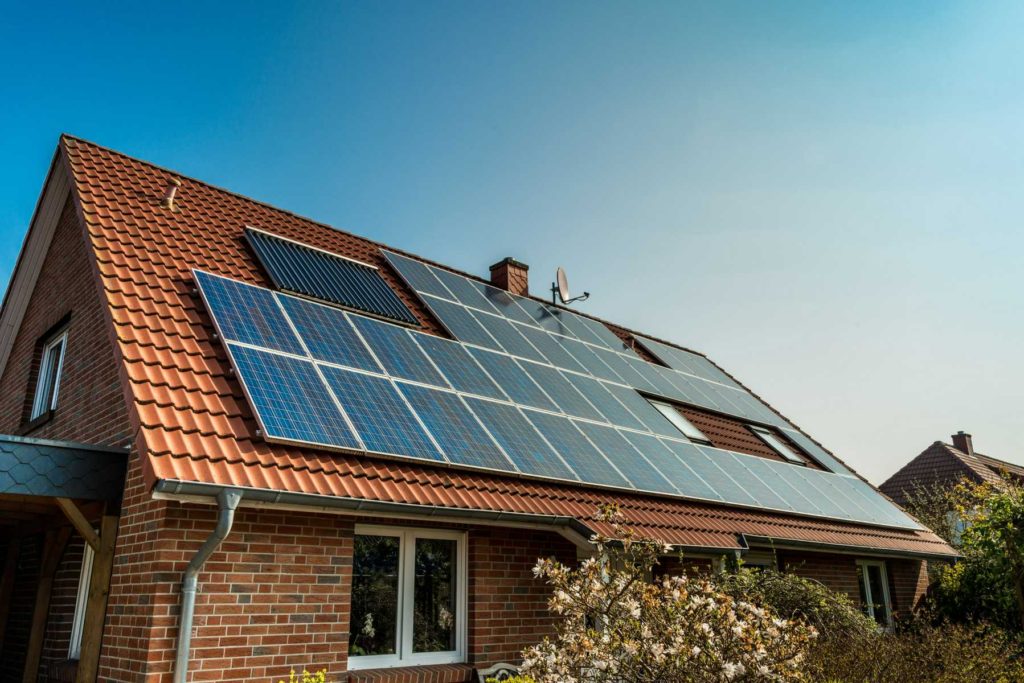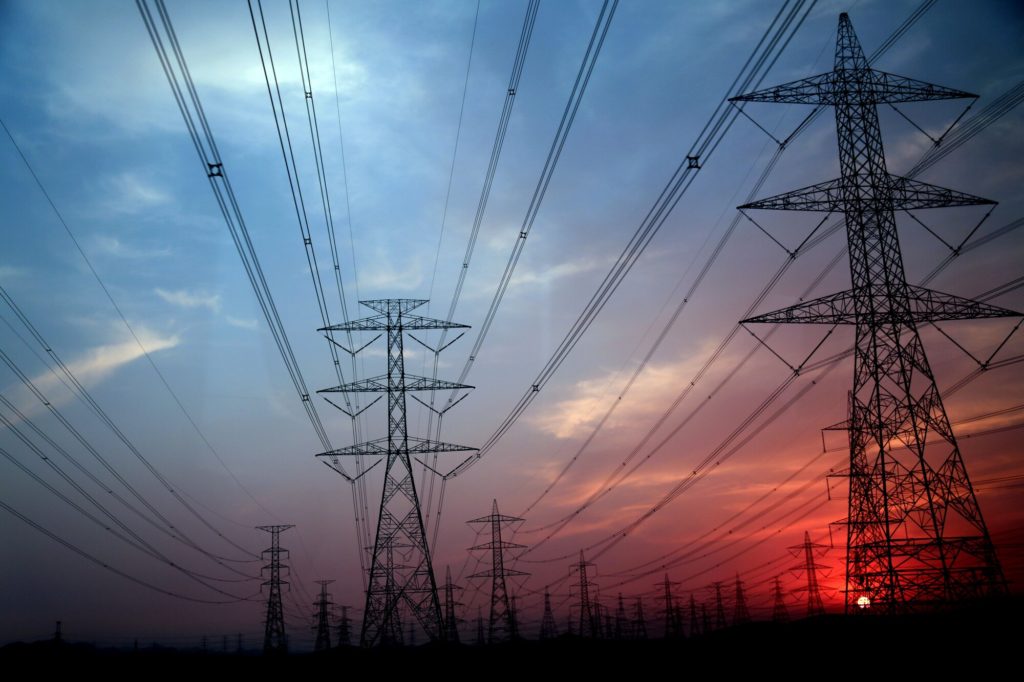All across the country, more and more Americans are installing solar panels for home use. And it’s easy to see why — you can save a considerable amount of money while also doing your part for the environment. Despite the growing popularity of residential solar power systems, many people still have questions about selling a home with solar panels.
If you are looking to buy or sell a solar home, you will want to know how much you can expect the home solar power system to affect its value. As it turns out, there’s a big difference depending on whether you own your solar panels, financed them with a solar loan, or entered into a purchase power agreement (PPA). There are also some more specialized methods for acquiring solar panels for your home that are only available in certain parts of the country.
Let’s discuss the details of each financing option and see how they affect the process of buying and selling homes.
Initial Expectations for Solar Homes
Before we dive too deep into the specifics, it’s important to point out that residential solar power systems almost always save homeowners a considerable amount of money. This is because, no matter how you purchase them, solar panels for your home produce energy at much lower rates than the vast majority of utility companies offer.
In addition, solar energy is far better for the environment than using electricity generated by fossil fuels. Still, not every homebuyer wants a home solar power system. That’s why you should know as much as possible about the home’s solar panels before you buy or sell the house.
The Four Most Popular Ways to Pay for Solar Panels
Not all solar panel purchases are created equal. It is true that solar panels for home systems typically increase the value of a home by roughly 3% to 5%. However, if you’re buying or selling a solar home, the value of the solar panels largely depends on how they were initially purchased. These are the most common ways to pay for residential solar power systems.
Up-Front Cash Purchase
If the home’s solar panels are fully owned, that’s the best-case scenario. When you buy solar panels with an up-front lump-sum payment, your financial responsibilities for that solar system end, other than some occasional routine maintenance. Solar panels purchased in this manner are the most valuable for home selling purposes because they’re entirely paid for.
Solar Loans
Residential solar power can be expensive to install. That’s why so many people choose to finance their purchases with solar loans. An interesting twist to this option is the fact that the original homeowner who entered into the contract will remain responsible for making loan payments. The contract does not automatically transfer to the new homeowner.
If the home you’re buying has a home solar power system on a solar loan, you should find out if the asking price includes funds to help the existing homeowner pay off that loan. That said, while you might encounter greater up-front costs helping the seller pay for their solar loan, you will still most likely benefit financially from the home’s solar system. As long as the additional costs outweigh the long-term utility bills, you will come out ahead.
Purchase Power Agreements (PPA)
Solar leases and PPAs are similar to solar loans, with a crucial distinction. When you finish paying for a solar loan, you own the solar panels. When you finish paying for a PPA or solar lease, solar power companies will either ask you to extend the agreement or buy the system from them. If you don’t, they will remove your residential solar power array.
In most situations, a PPA will last for around 20 years. Throughout the life cycle of the contract, your solar provider will perform all necessary maintenance and repairs, and they also typically monitor energy production from your system. One important note is that a PPA or solar lease will almost always include a buyout clause that allows the homeowner to purchase the solar panels outright or transfer the remaining lease period to a new homebuyer.
PPAs and solar leases usually provide homeowners with fewer financial benefits than either up-front purchases or solar loans. However, they often have minimal initial costs or none at all. As a result, buying out someone else’s PPA or solar lease isn’t always a great idea — the structure of the PPA often front loads the financial benefits. If you’re buying a home with a solar lease or PPA, keep this firmly in mind.
Property Assessed Clean Energy (PACE) Financing
The least common of these options is to finance solar panels for your home through a Property Assessed Clean Energy program. This is because financing through PACE is only available in certain parts of the country due to local government programs. PACE financing is most comparable to a solar loan. However, there is often no down payment, and the contract usually stipulates an annual payment, rather than monthly.
The most important aspect of PACE financing for a prospective homebuyer is that any remaining money owed on the solar system transfers to the new homeowner when they buy the house. With a solar loan, solar lease, or PPA, the original homeowner retains financial responsibility unless the new homebuyer agrees to the transfer. With PACE financing, this responsibility remains attached to the home, not the person who owns it.
In Conclusion
We’ve covered a lot of ground in this article, and it’s understandable if you still have some questions about the differences between up-front payments, solar leases or PPAs, solar loans, and PACE-financed solar systems. Feel free to contact LGCY Power today, and our expert representatives can help you figure out which is the best option for your home.
You’ve probably heard the sales pitch a million times: “Solar panels for your home can save you thousands compared to paying your utility bill!” In reality, there’s quite a bit of nuance involved when determining whether you should install a home solar power system. With that in mind, let’s take a deep dive into the different factors you need to consider when you’re thinking about taking the leap into residential solar power.
How Much Are You Currently Paying for Electricity?
The first aspect you need to consider is how much you’re currently paying for electricity. Depending on where you live, you might pay less than 10 cents per kilowatt-hour (kWh), or you might pay in excess of 20 cents per kWh. Obviously, how much money you stand to gain from installing solar panels is based largely on how much you’re paying for energy right now. The more expensive the rates charged by your local utility, the more money you can save with residential solar power systems.
It’s also crucial to consider how much you will be spending on solar panels for home installation. One of the main considerations in this area is how much energy your home consumes. If you have a small house, and your roof is in direct sunlight for much of the day, you can probably get away with a rather minimal setup. On the other hand, if you live in a large home — or if you don’t receive much direct sunlight — it could take a much larger solar system.
How Do You Plan to Finance Your Solar Panels?
Continuing along these lines, how you choose to finance your solar panels also matters. Buying solar panels for your home with an up-front payment will almost always provide the most significant long-term savings. Solar power companies often offer solar loans, which can also provide robust savings compared to using a typical utility company for your electricity, although not to the same level as paying cash.
The other common option is a power purchase agreement (PPA), which usually does not require a down payment and includes regular maintenance. The PPA will provide the least amount of cost savings but can still save you at least 10% compared to simply paying your utility bill.
Additionally, different states have different programs available for solar incentives. 2021 was scheduled to be the final year of the federal solar investment tax credit, which allows homeowners to deduct a large percentage of their solar costs. The expiration of this program is now unknown. Because the expiration of federal programs are unknown, state solar programs are even more important. Some states, like Florida and California, have generous solar incentives that can save you a tremendous amount of money. Meanwhile, other states (for instance, Arkansas) have no solar incentives of any kind.
Solar Energy Prefers Some Climates Over Others
The climate where you install your home solar power system also plays a significant role. In general, solar panels will produce more energy when they’re located in sunny, dry climates as opposed to cloudy, wet areas. That’s why residential solar power is so popular in the American Southwest and relatively less so in the Pacific Northwest.
How Long Does It Take For a Solar Install to Pay For Itself?
The vast majority of residential solar power installations pay for themselves over time, but how long does that take? The answer to this question has quite a bit of nuance, as it varies depending on the frequency of direct sunlight, the cost of electricity from utility companies, and the available solar incentives. For the most part, a typical American homeowner’s home solar power system will likely pay for itself within about a decade.
When you consider that the typical solar panels for home installation last 25-30 years, it’s clear that you can save a significant sum by installing solar panels. The best solar panels for home systems can last even longer! Once you hit the break-even point on your system, the rest of your residential solar power system’s life cycle is basically free energy.
Solar Panel Maintenance
We should probably also discuss the issue of maintenance. Thankfully, solar panels are quite simple to maintain, so this aspect shouldn’t sway your decision too much. You will occasionally need to clean dirt and debris off of your panels, and you might need to do some snow removal in the winter. Other than that, there isn’t much maintenance required for residential solar power systems.
Do solar panels increase the value of your home? For the most part, yes. According to the Office of Energy Efficiency and Renewable Energy, you can expect a typical residential solar system to add roughly $15,000 to the value of your home. However, it’s worth noting that this figure can vary considerably based on your location.
Still Have Questions?
If you have any remaining questions about whether installing solar panels for your home pays off, feel free to contact LGCY Power at your convenience. Our solar experts can help you figure out if installing solar panels for your home is a wise decision, and we can also assist you to choose the system that’s right for your home.
As you can see, there are quite a few variables involved when determining how much money you can save by installing residential solar panels. However, for most people, you will end up seeing noteworthy cost savings someday. The big variable is how long it takes for your solar system to pay for itself. In some situations, it can take as little as just a few years, but in other cases, it could take decades. Make sure you understand how these variables will affect your home before you purchase your solar panels!
People are often surprised by the high costs when they install solar panels for their homes. After all, the price of the panels themselves is sometimes just the tip of the iceberg when it comes to how much residential solar power systems cost. Depending on where you live, which company you purchase your solar power system from, and other variables, you may have to make a significant investment that costs more than the actual solar panels themselves.
Why are solar panels so expensive? One of the reasons for the high costs is that solar installers sometimes bundle in other expenses to cover their marketing, labor, and overhead. You can avoid these high costs by comparing bids from multiple companies and choosing a company that keeps the additional charges to an absolute minimum.
The Condition of Your Roof Matters
However, we will note that sometimes these added costs are justified and necessary. For instance, the condition of your roof plays a significant role. If your roof requires any repairs, you’ll need to complete these before installing your solar panels. Furthermore, if you have a roof with an especially steep angle or several different levels, it can be much more difficult to install your panels as opposed to a structure with a “typical” roof.
Environmental Factors
Environmental factors like trees and landscaping can make an impact as well, as can the quality of the existing electrical wiring in your home. Making sure your roof is accessible and your electric system is up to code goes a long way toward mitigating these extra expenses.
Where You Live
There are many other variables that affect the cost of solar panels for the home. One of the most impactful factors is your location. Different parts of the country receive differing amounts of sunlight on a typical day, which can dramatically increase or decrease the efficiency of your solar installation.
Solar panels, in some parts of the Pacific Northwest, will only receive around four hours of direct sunlight per day, while some areas in the American Southwest get eight hours or more. The less direct sunlight your panels receive per day, the more panels you need to power your home.
Solar Panel Quality
Another variable is the quality of the solar panels you purchase. Of course, higher-quality panels will cost more up-front, and you can save quite a bit of money on initial setup costs if you opt for less durable panels. However, this is a double-edged sword. The money you save up-front on cheaper solar panels will likely come back to bite you in the long run, as those panels degrade faster than more expensive ones.
Solar Incentives Influence Overall Cost
Solar panels can also be much more expensive if you live in an area without sufficient solar incentives. The federal solar investment tax credit will expire in 2022, meaning the 22% deduction homeowners enjoy for solar installations in 2021 is on its way out. Beyond that, it all comes down to the solar incentives offered by your individual state, and those vary considerably depending on where you live.
Choosing to Buy or Lease Solar Panels
Whether you buy or lease your solar panels can play a major role in how much solar panels for your house cost. Buying your solar power system up-front requires a significantly higher initial investment, but it also means that you’ll enjoy more robust savings down the line.
LGCY Power Is Here to Help
As you can see, there are quite a few layers involved when answering the question of how much residential solar panels cost. If you need some help figuring out how much solar panels for your home will cost, feel free to contact one of our LGCY Power Energy Consultants at your convenience. Our expert representatives can walk you through every expense involved with residential solar panel installations to help you determine the most cost-effective plan for you.
Have you considered going solar at home?
Just look around your neighborhood and you’ll see that more and more homes have solar panels on their roofs. But if you’re still using expensive and inefficient traditional utilities, you may not realize that solar power is actually the fastest growing form of clean energy in the world.
Don’t worry—we have plenty of fun facts about solar energy so you can impress your friends and neighbors!
Today, let’s start with these five interesting facts about solar energy:
Going solar really helps our environment and health.
Going solar and breaking our dependence on archaic fossil fuels brings a host of environmental benefits.
For instance, did you know that by curbing pollution, it’s projected that solar power can reduce our health and environmental costs by $167 billion each year? Solar also reduces water scarcity, saving enough water to provide for 1.3 million households annually. Finally, by going solar we could save $259 billion in damages directly linked to climate change just this year.
From the globe to your neighborhood, solar helps clean up the environment, which benefits us all.
Solar saves you a LOT of money – starting from day ONE.
These days, it’s more important than ever for the typical family to save money, and our power bills really add up. In fact, the average household drops $173 per month on their utility bills, including electric, and that could go way higher for bigger homes and in warm weather months.
By partnering with the top solar installers and utilizing only state-of-the-art technology, most homeowners begin saving the day they flip the switch. When we’re talking fun facts about solar energy, one of the most important aspects is the savings, all starting when you flip the switch on your brand-new solar system.
Installation is smooth and easy.
Solar is more affordable and saves you more than ever, and the installation process has never been easier. LGCY Power assigns you a dedicated Solar Consultant, who is like your personal solar concierge, leading you through the process, and handling all of the paperwork. LGCY even manages the permits, goes over options, and coordinates the installation.
Homeowners can even opt for maintenance and monitoring services, so going solar at home is not only one of the smartest choices you’ve ever made, but an enjoyable experience.
Renewable energy sources like solar will dominate by 2050.
The solar revolution is here, and it’s set to change the world over the next few decades. In fact, renewable energy sources like wind and especially solar are set to replace the majority of fossil fuels by 2050. (To put that growth in perspective, in 2015, wind and solar made up only seven percent of our global energy usage.)
There are many reasons for this dramatic increase, including improved technology, battery capacity, and infrastructure, but the bottom line is that fossil fuels are just getting more expensive. At the same time, it’s finally dawning on people how cheap, clean, and easy it is to tap into the power of the sun.
Now when your friends ask you, “What are some interesting facts about solar energy?” you’ll be ready!
Contact LGCY Power if you have any questions or for a complimentary solar assessment.
Solar energy provides clean, inexpensive energy for more Americans than ever before, with LGCY Power at the forefront of helping homeowners who want to save. But to understand where we’re going, it’s also important to understand the history of solar energy.
So, if you’ve ever wondered, “What is the history of solar energy?” read on!
The power of the sun was first harnessed by human beings in the 7th century B.C., when primitive magnifying glasses were used to light fires.
By the 3rd century B.C., the Romans and Greeks used mirrors to magnify the sun and light their torches used in religious ceremonies. These “burning mirrors” became commonplace, with a record of this newest solar “technology” even in Chinese civilizations.
In the 1500s, the iconic Italian technologist Leonardo da Vinci envisioned large concave mirrors to heat buildings and homes, which he sketched like so many other inventions.
Around that time, wealthy Europeans started having sunrooms or early green houses built to provide solar heat and grow exotic fruits that otherwise wouldn’t thrive in that climate.
The Birth of Modern Solar Energy
But it’s not until 1839 when we see the birth of modern solar energy. It was then that a prodigious young French scientist named Edmond Becquerel discovered the photovoltaic effect, a chemical and physical process where current or voltage is generated when a material is exposed to sunlight.
By the 1860s, a French mathematician named Augustin Mouchot registered the first patents for solar-powered engines, although they were far from usable in everyday life.
In 1873, the mineral selenium came to the forefront of solar power’s evolution, as electrical engineer Willoughby Smith discovered that the element had the potential for photoconductivity. That led to a revelation just three years later by English physicists William Grylls Adams and Richard Evans Day that selenium can create electricity when exposed to sunlight.
The Design of the First Solar Cells
Any discussion about the history of the development of solar energy wouldn’t be complete without Charles Fritts’ contribution. In 1883, this New York inventor designed the very first solar cells, constructed from selenium and a thin gold layer. Fritts installed these primitive solar panels on the rooftop of a New York City building. His invention only reached an energy conservation rate of 1-2 percent (while most modern solar cells operate at 15-20 percent efficiency), but these cells did produce electric current “that is continuous, constant, and of considerable force” according to Fritts’ account.
But it was another inventor, Edward Weston, who received patents for those solar cells, U.S. Patent 389,124 and U.S. Patent 389,425, in 1888. That same year, Russian scientist Aleksandr Stoletov invented the first solar cell that utilized the photoelectric effect, discharging electrons when light hit the cells.
After that, new patents came periodically, with American inventor Harry Reagan receiving a patent in 1897 for thermal batteries charged by solar energy. Another patent came in 1913 when William Coblentz designed a thermal generator that was more practical than ever before.
The Introduction of the Photovoltaic Cell
Our look at solar energy history facts takes a huge leap forward in 1954 when Bell Laboratories designed the silicon P.V. (photovoltaic) cell. There at Bell Labs, inventors Daryl Chapin, Calvin Fuller, and Gerald Pearson came up with the first-ever solar cell made of silicon – not selenium – that reached 4 percent efficiency at converting sunlight to power. With subsequent developments, they quickly reached 6 percent efficiency, but installing solar panels on a building or residential property was still a far-off concept.
One of the notable events in the brief history of the development of solar energy came with space exploration, as solar power was used to help power satellites, including Vanguard I, Vanguard II, Sputnik 3, and Explorer III, all in 1958. By 1964, NASA launched their Nimbus spacecraft satellite, which ran completely on 470-watt solar power. NASA used solar to power space exploration again in 1966 with the first Orbiting Astronomical Observatory.
Solar One: The World’s First Solar Building
In 1973, the University of Delaware created “Solar One,” the world’s first solar building. It didn’t have solar panels, but the solar capacity was built right into the rooftop materials, using a combination of solar P.V. power and solar thermal.
When the United States was thrust into an energy crisis in 1974, Congress quickly passed the Solar Energy Research, Development and Demonstration Act. With that, the U.S. government pledged to “make solar viable and affordable and market it to the public.” For the first time, it seemed that solar energy in normal life seemed viable for the near future. However, the path of growth for solar slowed in the 1980s when energy prices dropped precipitously.
The endorsement of solar power for the nation was a mercurial issue for U.S. presidents, too. President Jimmy Carter had solar panels installed on the White House in 1979, but President Ronald Reagan had them removed in 1981. It wasn’t until 2010 when President Barack Obama asked for solar panels to be re-installed at the White House, as well as a solar hot water heater.
The Solar Challenger: First Aircraft to Run On Solar Power
Solar development got an unlikely boost from the aviation field in 1981 when Solar Challenger became the first aircraft to run entirely on solar power, flying from France to the U.K. Thirty-five years later, in 2016, Solar Impulse 2 became the first aircraft to fly around the globe with solar power and zero emissions.
As we transition from the history of solar energy to the present day, it becomes clear why residential use of solar is more popular than ever. According to the Solar Energy Industries Association, the prevalence of solar energy has grown by an average of 50 percent annually over the last ten years. This is largely thanks to the Solar Investment Tax Credit, which was enacted in 2006. But the technology of solar systems, from panels to batteries, has also vastly improved. In fact, installation costs are now 70 percent less than just ten years ago.
Today, solar power is less expensive, easier, and more efficient than ever, and LGCY Power is the national leader in solar power for homeowners looking to save on their energy bills.
Call LGCY Power at 1.866.566.2650 and speak with one of our experienced solar professionals. Our solar experts will answer your questions about making the switch to solar power and will demonstrate how going solar will save you money in as little as one month’s time.
Twice a year, most of us set our clocks forward or back in observance of Daylight Savings Time. Whether it’s springing one hour forward in March or falling back one hour in November, Daylight Savings Time (DST) gives us an extra hour of daylight in the evenings during the winter season when days are shorter. According to Scientific American, approximately 25 percent of the world’s population observe daylight savings, losing an hour of sleep or gaining an hour of sunlight.
However, being able to work and play an extra hour wasn’t the only purpose for Daylight Savings Time. So, does Daylight Savings Time save energy, too?
There are plenty of studies and even a little controversy surrounding the question, how does daylight savings time save energy? So, it’s first important to look at the history of Daylight Savings.
The History of Daylight Savings Time
Daylight Savings didn’t come to fruition until World War I, when Germany saw that an extra hour of sunlight would help with work, wartime production, and conserve energy. By the end of WWI, the United States was doing the same, asking Americans to set the clocks back as a temporary wartime measure, and they picked up the practice again in WWII to stretch the days and conserve energy.
Once the war ended, it fell to individual states to decide if they wanted to observe Daylight Savings Time, as well as the schedule of dates. But in 1966, Congress passed the Uniform Time Act of 1966, turning the clocks back one hour on the last Sunday in October and forward one hour on the last Sunday in April.
If those dates don’t sound entirely familiar, it’s because in 2007, those dates were adjusted to the first Sunday in November and the second Sunday in March.
Now that we’ve caught up with the history of Daylight Savings Time, let’s focus on the crucial question, how does Daylight Savings Time save energy?
How Does Daylight Savings Time Save Energy?
The conventional wisdom went that if we are able to spend an extra hour outdoors, we wouldn’t need to turn on lights, watch televisions, or use other appliances, saving electricity. Just by keeping the lights off for an hour, Daylight Savings Time saves energy, right?
Of course, some thought daylight savings was a great idea and lobbied hard for it, like retailers and farmers, among others who would benefit. (In 1986, lobbyists for the golf industry told Congress that an additional four weeks of daylight savings would generate about $400 annually in extra revenue and sales on golf courses across the country!)
What The Research Says About Daylight Savings
Those opinions aside, let’s look at the research to see how Daylight Savings Time saves energy (if at all).
In the 1970s, during the U.S. oil crisis, the U.S. Department of Transportation conducted a study and found that Daylight Savings Time (DST) decreased overall electricity consumption by 1 percent, but not because of its intended effect – reducing home energy and heating needs.
The U.S. Department of Energy published a report in 2007 when Congress extended DST four weeks. Their findings were consistent with the DOT, as saving daylight only lowered energy use by 0.5 percent (half a percent) each day. They discovered that although there was some nominal energy savings in the late afternoon/early evenings, people used their heat and lights more in the mornings. In total, Daylight Savings Time saved the country only 1.24 terawatts or 0.03 percent of our total electricity demand.
That may seem like nominal electricity savings, but in their 2008 report on that analysis, the DOT noted that 1.24 terawatts could power 100,000 U.S. households for a whole year. Additionally, their study looked at residential power savings but not the effect of DST on commercial energy usage, which could offer more savings.
The extension of Daylight Savings Time in 2007 also provided a valuable opportunity to compare the before-and-after energy usage and test its efficacy to save energy.
Adrienne Kandel, an economist for the California Energy Commission, did just that, conducting a study into California’s energy usage before and after the 2007 extension of DST. She found that Daylight Savings had little or even no effect on how much energy was used in that state. The energy savings was only 0.2 percent over those extra weeks of DST, well within the 1.5 percent statistical margin of error.
Another valuable opportunity for a before-and-after comparison came in 2006 when Indiana adopted Daylight Savings Time statewide. By studying electricity usage, they found that DST actually increased demand for electricity by 1 percent, costing Indiana residents an additional $9 million.
A large-scale European study found that Daylight Savings initiatives reduced the energy used for lighting only marginally, but the demand for home heating actually increased by 9 percent, making DST a resounding net negative.
And a report by the National Bureau of Economic Research in the U.S. found that while energy for lighting did decrease, the use of power for heating and cooling rose significantly.
Accurately gauging if Daylight Savings Time saves energy is a tricky proposition. This smattering of studies and reports also lack any uniform scientific methodology, and many factors are at play.
For instance, through the 1960s, it was lighting that cost us the most in electricity, although now lighting has become exponentially more efficient – and cheaper. In the 1970s, it was the skyrocketing price of oil that dictated the lion’s share of energy costs, altering the DST savings equation.
DST May Hurt Home Energy Savings in Certain States
These days, we use air conditioning far more on early summer evenings and turn on the heat during chilly mornings in the early spring and late fall, dispelling the idea that DST lowers energy usage. In states where air conditioning is needed almost year-round, DST may actually hurt, not help, home energy savings. (That’s the big reason why Arizona hasn’t adopted DST.)
Likewise, latitude matters when we wonder how Daylight Savings Time saves energy, since an extra hour of daylight in northern latitudes with colder climates may be far more valuable than southern and warmer regions. We also use our computers, electronics, and smart appliances almost constantly, so an extra hour of daylight won’t make an impact. Most of these studies also look only at residential electric bills, not commercial buildings, retail spaces, or offices.
The Best Way To Save On Solar
No one is really sure if the sun will set on Daylight Savings Time and we will go back to a uniform time, but one thing is for sure: the best way to save money on your energy and electricity bills is to go solar at home with LGCY Power. Solar power is now cheaper, easier, and more efficient than ever, and LGCY Power is at the forefront of America’s solar revolution.
Given that solar panels generate electricity through sunlight, your residential solar system will obviously spend all of its time outdoors. This means that your solar panels will be exposed to all sorts of conditions, from typical rain and snow to extreme winds and temperature swings. Your panels might even have to withstand severe weather events like hurricanes, tornadoes, hail, and more.
Therefore, it’s understandable that many homeowners have questions about how solar panels perform in a variety of weather conditions. Does extreme weather reduce the lifespan of a solar panel? Is there such a thing as all-weather solar panels? Throughout this article, we’ll fill you in on all of the important details.
Heat and Sun
Of course, sunshine is a good thing for solar panels. The more sunlight your panels receive, the more power they generate — it truly is just that simple. However, what if you live in a city like Phoenix, AZ, that frequently sees temperatures spike into the 100s? Is there a level of heat that becomes too much and causes the panels to crack?
Fortunately, most solar panels can handle temperatures up to around 150 degrees. Even then, it’s likely that the panels would merely lose efficiency instead of becoming damaged. It doesn’t matter much how hot it gets — if your solar system is in a sunny city like San Diego, CA, your solar panels will likely perform at an optimal level.
Cold and Snow
There’s a common misconception about solar panels in cold weather. While you might think that cold weather decreases the efficiency of your residential solar installation, this has no basis in fact. There are some winter conditions that can reduce solar panels’ effectiveness — such as the angle of the sun — but cold temperatures can actually boost efficiency.
What if you live in a city like Baltimore, MD, where heavy snowfall is somewhat common during the winter months? Much like solar panels in cloudy weather, it’s important to note that snow-covered solar panels won’t produce as much energy as a clean panel, but it’s highly unlikely that your panels will buckle under the weight of the snow. Furthermore, solar panels are typically installed at an angle that allows snow to slide off harmlessly.
Wind, Hurricanes, and Tornadoes
For the most part, windy conditions shouldn’t have much of an effect on your solar panels. Of course, if your home is directly in the path of a hurricane or tornado, it’s possible that you could lose your entire roof. However, in the vast majority of other high-wind scenarios, your solar panels will be in no danger. Furthermore, the wind does not affect solar panel performance.
Hail
If you live in the Midwest, your home is likely subjected to the occasional hailstorm. Thankfully, solar panel manufacturers planned ahead for this occurrence. The vast majority of solar panels are constructed to withstand much more severe impacts than the typical hailstorm provides. In fact, most solar panel manufacturers build their panels to withstand twice as much force as the impact from a severe hailstorm.
In Conclusion
While it’s true that weather does have an effect on residential solar systems, solar panels and weather tend to mix better than people think they do. Solar manufacturers are well aware that their products will need to withstand a variety of harsh conditions, and it’s going to take a lot more than rain, snow, or hail to damage your panels. Furthermore, while all-weather solar panels aren’t available quite yet, efforts are underway to create even stronger panels that can withstand anything Mother Nature sends their way.
For more information about extreme weather effects on solar panels, contact LGCY Power today. Our representatives are true experts who are familiar with everything there is to know about solar panel performance in various weather conditions. They can help you figure out the best options for your home and choose the right panels for your solar system.
Solar power is gaining popularity in the United States, with more people opting for the savings and clean energy that LGCY Power provides. According to a recent survey by the Pew Research Center, 77 percent of Americans say that it’s more important to develop clean energy sources like solar than produce more fossil fuels.
But, while solar power usage has grown 460 percent from 2008 to 2018, we still rely on coal, petroleum, and natural gas to generate about 80 percent of our country’s power. What’s holding us back? A lot of it is just education, which will lead to even more widespread adoption of solar power in our daily lives. So, today we would like to provide you with more information on the advantages of solar energy vs fossil fuels.
The main considerations we’ll use to judge the two are:
1) Cost of power
2) Negative environmental impact
3) Ease of integration and use
4) Pros and cons
1) The cost of fossil fuels vs solar energy
When we talk about comparing the cost of solar electricity to fossil fuels, it’s important to note the prevalence of government subsidies. In fact, the United States government has subsidized traditional fossil fuels at a higher rate than any other country in the world according to EnergySage.com.
For example, the Investment Tax Credit (ITC) actually covers 26 percent of most solar installations in the United States. That has been true even under even the most environmentally friendly administrations and Presidents. Therefore, the best way to compare apples-to-apples when we talk about energy costs is to turn to a more straightforward metric: global energy prices.
Update: In August 2022, the solar tax credit was increased to 30% and extended through 2032.
Traditionally, the price of electricity generated from fossil fuels like coal, natural gas, and other fossil fuels ranges between $0.05 and $0.17 per kilowatt-hour. Currently, the price of solar energy runs between $0.03 and $0.06 per kilowatt-hour according to the National Renewable Energy Laboratory. So, solar power costs about half as much as electricity produced from non-renewable sources (and that’s not factoring in indirect costs like environmental harm, etc.).
While the savings with solar are profound, the potential for even lower energy prices in the future is exciting. Remember that solar is not a fuel but a technology. Therefore, it’s not a limited resource like gas, oil, coal, etc., which can only increase in price as the supply shrinks. Conversely, advancements in solar technology will improve dramatically over the coming decades, making solar power the cost-efficient choice to power our lives.
2) The environmental impact
When it comes to environmental impact, solar is the clear winner. Solar energy harnesses the power of the sun, cleanly and without harmful emissions or pollutants. We don’t need to mine, drill, burn, or deplete a finite resource to obtain an endless abundance of solar energy.
Fossil fuels, however, deplete and degrade the Earth in the process of obtaining them, causing serious and irreversible changes to the Earth’s fragile ecosystem. Fossil fuels also emit harmful pollutants such as greenhouse gasses, poisoning our environment for future generations. For instance, the burning of fossil fuels now accounts for three-quarters of all carbon emissions in the United States according to NRDC.org. Our dependence on non-renewable fuels also leads to indirect effects like armed conflicts, food insecurity, price volatility, deforestation, and more.
3) Integration and use
Currently, renewable energy resources like wind, solar, and hydropower make up only 2-3 percent of energy usage for the whole world (and about 4 percent in the United States). Non-renewables like oil, coal, and natural gas still make up the vast majority of our energy usage, despite their higher cost and harm to the environment.
Part of the reason for that dependence on non-renewable fuels, is the infrastructure and distribution system, which has been entrenched in our society for more than 100 years. When it comes to ease of filling up your car’s gas tank or calling up the utility company to connect electricity at your house, non-renewables have an edge.
But the use of clean energy is becoming more practical by the day, already surpassing fossil fuels in terms of cost savings. As technology around solar panels, batteries, and other solar systems keeps developing, the application of clean energy sources in everyday life will become more widespread.
4) Solar energy vs fossil fuels pros and cons
To recap the pros and cons of solar energy and fossil fuels, we see that solar now costs less to produce (approximately half as much). The operating costs of fossil fuels will only grow over time as these finite, non-renewable resources are depleted.
Solar Power, on the other hand, will most likely drop in price and increase in efficiency since it’s a technology and not a power source.
Fossil fuel dependence comes with serious environmental consequences, like water pollution, soil erosion, global warming, and more.
When we talk about solar energy vs fossil fuels, the only drawback to solar is that it’s not widely accessible yet, as improvements in infrastructure, technology, and energy policies are needed before there can be a solar panel on every rooftop. LGCY Power is at the forefront of that movement to bring solar to every American household!
Sources:
Solar Energy vs Fossil Fuels
Renewable Energy is Growing Fast in the US But Fossil Fuels Still Dominate
Renewable Power Costs in 2019
Solar vs Fossil Fuels
Fossil Fuels Dirty Facts
Today’s solar panels are far more efficient in a wide variety of weather conditions than the panels of yesteryear. However, there are still some situations where you could experience decreased output from your residential solar system. One of the most common weather events that affects efficiency is snow on solar panels. How much does snow accumulation decrease your solar system’s energy efficiency? And how do you clean snow off solar panels? Let’s dig into the details.
Solar Panels Are Built To Withstand Snow
First off, let’s correct one of the most enduring myths about solar panels. Many people think that solar panels and snow don’t mix well. In actuality, your typical solar panel is manufactured to withstand at least two feet of snow, and most of them go well beyond that level. Considering that solar panels also function quite well in cold weather, there is little-to-no risk of your panels becoming damaged by snow or other wintery conditions.
How do solar panels work with snow on them? While it’s unlikely that your solar panels will be damaged by winter weather, it is true that heavy snowfall can block sunlight from reaching your panels. Because your solar system needs direct sunlight to produce energy, this can have a negative effect on your electricity generation.
However, before you jump up on the roof and start brushing the snow off of your solar panels, you should check with your solar manufacturer. Some solar companies will void your warranty if you remove snow from your panels yourself. If you get the go-ahead from your manufacturer, you can try either sweeping them using a roof rake or a long-handled brush, or you could blast them with water from a hose to melt the snow away.
How To Remove Snow From Solar Panels
Use The Cold Water Method
If you choose the water method, make sure you use cold water, as the temperature differential between cold snow and hot water could crack the glass on your panels. Furthermore, anyone sweeping or raking snow from solar panels should attach a soft cover to make sure you’re not scratching the glass. You should also never use RainX, car wax, rock salt, or other chemicals on solar panels, as all of these materials can cause damage to not only your solar system but also the shingles and other structures on your roof.
The Autonomous Solar Panel
That said, there are some more advanced methods regarding how to remove snow from solar panels on the roof. One option is a relatively recent innovation known as an autonomous solar panel. These panels can sense when there’s snow cover, and they transfer a small amount of energy in the form of heat to clear away the snow. In addition, the Minnesota-based “Solar for Snow” organization recently won a $50,000 prize from the National Renewable Energy Laboratory for their plan to produce solar panels that include nano-materials to self-heat snow-covered panels.
Wait For It To Melt or Slide Off
To be honest, sometimes the best way to get rid of snow on solar panels is to simply wait for it to melt or slide off. Unless there’s a significant amount of caked-on snow cover preventing your solar system from accessing sufficient sunlight, it’s unlikely that you’re losing a significant amount of production. Especially if your solar panels were installed at an angle of 35 degrees or greater, it won’t take much warming to loosen the snow enough to fall off.
Talk With Solar Experts at LGCY Power
As with most aspects of solar panel maintenance, if you have concerns about the buildup of snow on solar panels, you should ask a professional. Our LGCY Power representatives can tell you everything you need to know about how to get snow off of solar panels, and they can also help you figure out the best way to avoid too much snow buildup in the first place.
While solar panels and snow don’t exactly work in harmony, the negative effects of snow on solar panels can be a bit overblown. You might lose a bit of production here and there, but for the most part, it shouldn’t significantly decrease the energy generation from your residential solar system.
Because solar panels produce energy from direct sunlight, it’s pretty obvious that your residential solar system will typically produce more electricity in the summer than it will in the winter. However, there’s quite a bit more to it than you might think, and understanding seasonal solar panel performance can increase your household’s solar savings. Let’s discuss the many ways the seasons affect your energy output and how you can take advantage of them.
Solar Panels Work Best in the Summer Months
Why do solar panels work better in the summer? The longer days certainly help, as your solar panels receive sunlight for more total hours per day than they do in the winter. Furthermore, the angle of the sun provides additional solar panel savings in the summer because the sun’s rays are stronger when it’s directly overhead, as opposed to the lower angle of sunlight in the winter months. This also helps explain why a solar system in Orlando, FL will usually generate more energy per year than the same exact system in Baltimore, MD.
It can be surprising to analyze how much more production you get from your residential solar system during the summer as opposed to the winter. While exact energy levels can fluctuate significantly based on the size and style of your solar system, the age and quality of your solar panels, your location, and daily weather patterns, you can generally expect your system to generate up to 50% more energy in the middle of the summer compared to the dead of winter.
Two-Thirds of Energy Output for the Year Are Generated During This Time
In fact, if you split up the year into two equivalent six-month portions — with the “summer” half running from mid-March through mid-September and the “winter” half stretching from September back into March — nearly two-thirds of all energy output for the entire year is generated during the summer half. Of course, these statistics can also vary quite a bit depending on where you live.
If your residential solar system is located in a sunny city like San Diego, CA, or Phoenix, AZ, you might not notice nearly as much of a seasonal difference as a similar system in North Dakota would experience. Furthermore, some areas (like the majority of the American West) receive most of their rain in the winter, while others (like the Southeast) experience rainy summers. In other words, how solar panels work in the rainy season (and when that season occurs) also plays a part.
Electricity Usage Impacts Seasonal Solar Performance
Electricity usage is another factor that affects seasonal solar panel performance. Some people use more energy in the winter, especially if your home has electric heat instead of gas heat. Other people have higher energy usage in the summer when the air conditioning is cranked up to keep their homes cool. Depending on your specific electricity usage tendencies, your solar energy savings can vary between seasons.
Thankfully, there are solutions to all of these issues. The best way to ensure you have plenty of energy to power your home regardless of weather and climate concerns is to add a solar battery to your residential solar system. With a solar battery, you can store energy generated during peak production months and use it when your system’s output decreases. Solar batteries are a great way to maximize your solar savings and avoid purchasing supplemental energy from your utility provider.
Questions?
Do you have further questions about how seasonality affects your solar panel savings? Feel free to contact one of our LGCY Power representatives at your convenience. Our expert team members can assist you to determine how much of an effect the seasons will have on a solar system at your home and help you choose the perfect solar panels for your house. Understanding how energy production levels can fluctuate during different parts of the year can help you make the most of your solar energy savings, so give us a call today!


